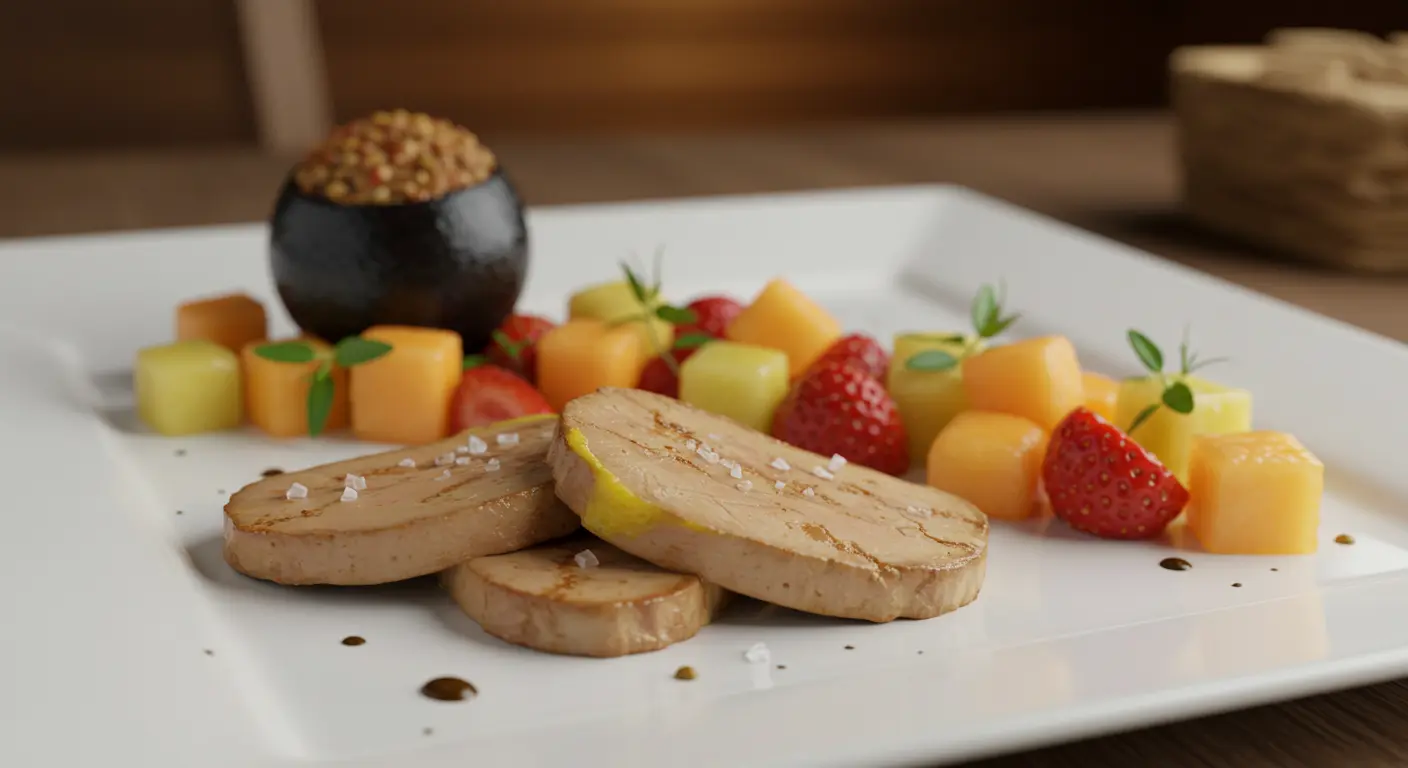I’ll never forget the day my friend, Chef Antoine, introduced me to foie gras torchon. “This,” he said, unwrapping a cloth-bound delicacy, “is a true luxury.”
He sliced the silky, buttery foie gras, placed it on toasted brioche, and handed me a bite. The moment it melted on my tongue—rich, velvety, with hints of truffle—I understood why this dish defines gourmet dining.
Now, I’m sharing this secret with you! Whether you’re curious about its history, how chefs serve it, or even how to make it at home, you’re in for a treat. Let’s dive in!
Table of Contents
What Is Foie Gras Torchon? A French Culinary Masterpiece
Define foie gras torchon and how it differs from foie gras terrine, mousse, and pâté.
Foie gras torchon is a classic French delicacy that showcases the pure, unadulterated richness of foie gras with a velvety texture and delicate flavor. The name “torchon,” meaning “dish towel” in French, refers to the traditional technique of wrapping the foie gras in a cloth before poaching it gently, resulting in a smooth, creamy consistency. Unlike foie gras terrine, which is pressed and served chilled in a mold, or foie gras mousse, which is aerated for a lighter texture, foie gras torchon retains its dense, buttery mouthfeel. Foie gras pâté incorporates additional ingredients, creating a more rustic and spreadable preparation.
Explain its French origins and why it’s associated with luxury dining.
Foie gras torchon has deep roots in French culinary tradition, dating back centuries. Originating in the southwestern region of Gascony, foie gras has long been a symbol of luxury dining in France. The method of preparing foie gras torchon, where the liver is gently poached and wrapped in cloth, was perfected by French chefs to preserve the delicate flavors and texture. Over time, this preparation became associated with fine dining, often served in Michelin-starred restaurants and luxurious banquets. The dish’s rich, buttery profile and the meticulous craftsmanship required to make it solidified foie gras torchon as the epitome of gastronomic opulence.
Famous Michelin-starred chefs who serve foie gras torchon.
Several renowned Michelin-starred chefs have embraced foie gras torchon as a signature dish, elevating it to the pinnacle of fine dining. Joël Robuchon, often hailed as one of the greatest chefs of all time, was known for his impeccable foie gras torchon, paired with luxurious accompaniments. Likewise, Alain Ducasse, a culinary icon with numerous Michelin stars, often serves this delicacy in his prestigious restaurants, where it is prepared with the utmost precision. Pierre Gagnaire, another celebrated chef, crafts foie gras torchon with unique, innovative touches, ensuring that each bite reflects the sophistication and elegance of French gastronomy.
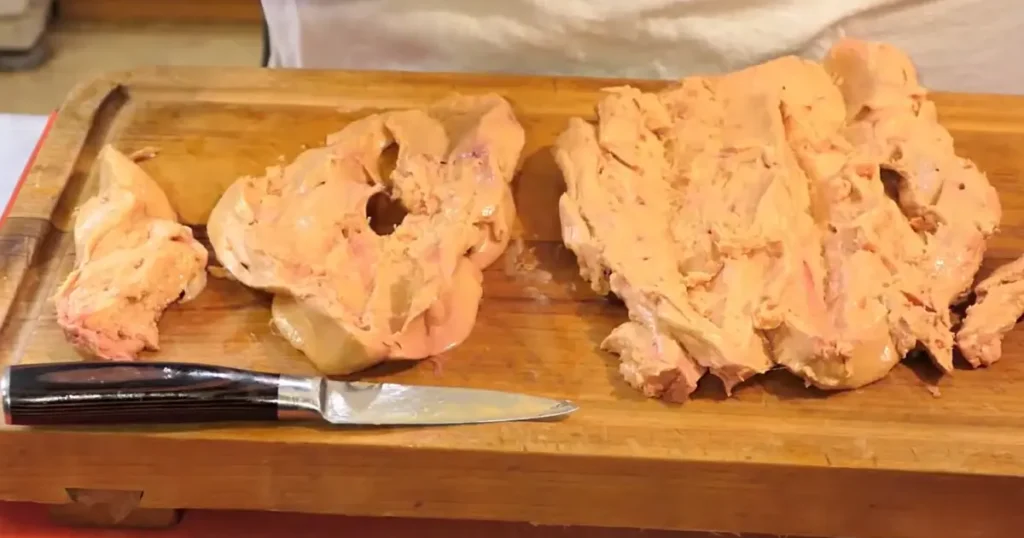
The Traditional Method: How Foie Gras Torchon Is Made
Step 1: Selecting the finest duck or goose liver
The first step in crafting a perfect foie gras torchon is selecting the finest liver. Duck and goose livers from the renowned Gascony region of France are ideal, and they are known for their exceptional quality and rich flavor. Rougié, a trusted producer, provides some of the most coveted foie gras, celebrated for its superior texture and subtle nuances. When choosing the liver, ensure it is fresh, with a smooth, firm consistency and a deep, rich color. The quality of the liver is essential, as it serves as the foundation for the luxurious, melt-in-your-mouth experience that defines foie gras torchon.
Step 2: Seasoning & marinating
For the second step in preparing foie gras torchon, seasoning and marinating are crucial to enhancing its flavor. Start by generously rubbing the duck or goose liver with Maldon sea salt, which brings out the natural richness of the foie gras. Next, add a dollop of truffle butter to introduce a layer of earthy, luxurious flavor that complements the buttery liver. A splash of cognac adds a subtle, aromatic depth to the dish. Allow the foie gras to marinate for several hours, letting the flavors meld together, ensuring each bite of foie gras torchon is a harmonious balance of richness and refinement.
Step 3: Shaping and wrapping the liver into a cloth
Once the foie gras has been seasoned and marinated, the next step is shaping and wrapping the liver into a cloth—this is where the term foie gras torchon originates. Take a clean, damp kitchen towel or cheesecloth, and carefully wrap the duck or goose liver inside. The cloth helps maintain the liver’s shape while ensuring even cooking. Tightly secure the cloth with twine, creating a compact bundle. The foie gras torchon is now ready for poaching. This technique not only helps achieve the desired smooth texture but also enhances the delicate presentation once the foie gras is unwrapped and served.
Step 4: Poaching and chilling to achieve the perfect smooth texture.
The final step in creating the perfect foie gras torchon involves poaching and chilling. Gently immerse the cloth-wrapped foie gras into a pot of simmering water, ensuring the temperature does not exceed 85°C (185°F). Poach for about 30 to 40 minutes, allowing the foie gras to cook slowly and evenly. This technique ensures the liver remains delicate and retains its rich, buttery texture. Once poached, remove the foie gras torchon from the water and allow it to cool. Transfer it to the fridge to chill for several hours, which further refines the texture and allows the flavors to intensify, resulting in a smooth, melt-in-your-mouth experience.
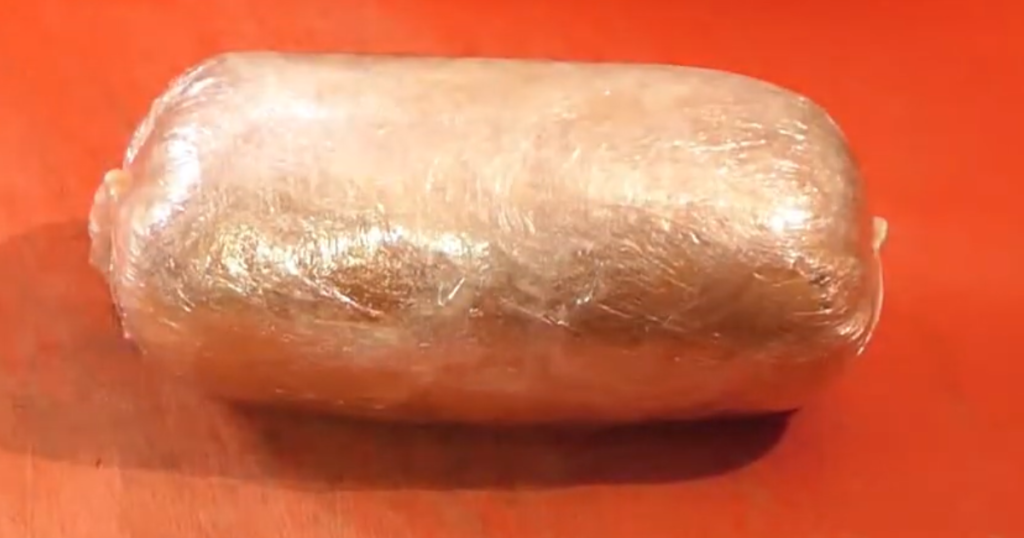
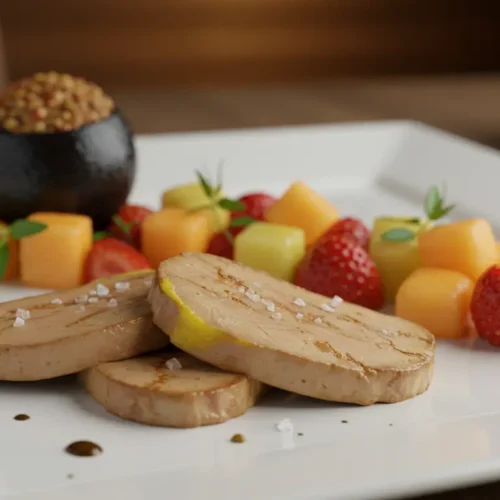
Foie Gras Torchon Recipe
Equipment
- Gram scale
- Cheesecloth
- Sushi rolling mat
- Spice grinder
- Kitchen twine
- Tweezers
Ingredients
- 1 entire Grade A or Grade B fresh foie gras 500 to 750g
- 75 g salt
- 25 g sugar
- 12.5 g pink curing salt optional
- 10 g white or black pepper
Instructions
Prepare the Foie Gras:
- Let it rest at room temperature for 45 minutes, then split into two lobes. Remove veins carefully using a paring knife or tweezers. Refrigerate.
Create the Cure
- Grind salt, sugar, curing salt, and pepper into a fine powder. Weigh out 2.5% of the foie gras' weight in seasoning.
Season the Foie Gras:
- Spread it into a 9×9-inch square. Sprinkle half of the cure and Cognac on one side, flip, and repeat on the other side.
Roll the Torchon:
- Place on plastic wrap, roll tightly with a sushi mat, then wrap in cheesecloth. Twist the ends and secure tightly with twine.
First Curing Stage:
- Hang the torchon in the refrigerator for 1 to 3 days.
Poaching:
- Submerge in 160°F (71°C) water for 2 minutes, then transfer to an ice bath for 10 minutes. Pat dry.
Second Curing Stage:
- Re-tighten with twine and refrigerate for another 1 to 3 days.
Serving:
- Slice off the ends, unwrap, and cut into disks. Trim edges for presentation. Serve with coarse salt, toast, preserves, or dried fruits.
Notes
- Using metric measurements ensures accuracy for seasoning.
- La Belle Farms foie gras is recommended for best quality.
- Extra seasoning mix can be stored for future use.
How to Serve Foie Gras Torchon Like a Michelin-Star Chef
Best accompaniments: Brioche, toasted baguette, fig jam, or apple compote.
When serving foie gras torchon, choosing the right accompaniments is essential to enhance its luxurious flavor. Brioche, with its light, buttery texture, provides a perfect balance to the richness of the foie gras. Alternatively, a toasted baguette adds a satisfying crunch, offering a more rustic contrast. To complement the savory notes, a Woolworth Cheesecake introduces a sweet, slightly tangy element that cuts through the richness. For a more refreshing contrast, Apple Pie With Puff Pastry provides a subtle sweetness with a hint of tartness, brightening the dish and adding depth to each bite. These accompaniments elevate the dining experience, making foie gras torchon a truly unforgettable treat.
Plating techniques: How chefs create an elegant presentation.
When plating foie gras torchon, chefs focus on elegance and balance. A common technique is to slice the foie gras torchon into delicate, uniform portions, allowing its creamy texture to be showcased. The slices are often artfully arranged on a crisp, white plate, providing a striking contrast to the rich, golden hue of the foie gras. Accents such as microgreens, edible flowers, or a drizzle of rich balsamic reduction can enhance visual appeal while adding complexity. To complete the presentation, chefs may place a few carefully placed spoonfuls of fig jam or apple compote beside the foie gras, creating an aesthetically pleasing, flavorful composition.
Serving temperature: Why room temperature is key for the perfect buttery texture.
For the perfect experience, foie gras torchon should always be served at room temperature. When chilled, the liver becomes too firm, losing its signature, buttery texture. Allowing the foie gras torchon to rest outside the refrigerator for 15 to 20 minutes before serving ensures that it softens slightly, making each bite melt in your mouth. This subtle shift in temperature enhances the silky smoothness and richness, creating a more indulgent and luxurious dining experience. By serving at room temperature, the foie gras retains its delicate flavor and velvety consistency, highlighting the true elegance of this gourmet dish.
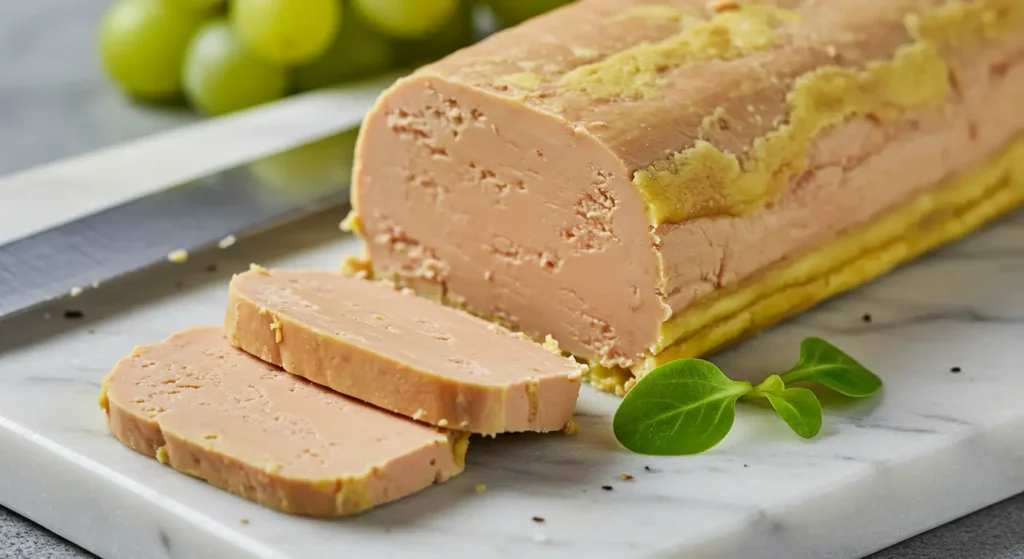
Where to Find the Best Foie Gras Torchon (Or Make It at Home!)
Top Michelin-starred restaurants known for foie gras torchon.
For those seeking an unforgettable experience with foie gras torchon, several top Michelin-starred restaurants offer exceptional renditions. Le Bernardin in New York serves a refined version, highlighting the luxurious texture of foie gras torchon with delicate accompaniments. In Paris, Le Meurice, a 2-star Michelin restaurant, presents a creatively enhanced version, fusing classic French techniques with modern twists. In London, The Ledbury has garnered acclaim for its interpretation of this dish, pairing it with seasonal, locally sourced ingredients. These prestigious restaurants are where culinary excellence and the richness of foie gras torchon come together for a truly indulgent experience.
Best online stores and gourmet markets to buy high-quality foie gras.
When searching for premium foie gras torchon, several online stores and gourmet markets offer exceptional selections. D’Artagnan is a trusted online retailer known for its high-quality foie gras from Gascony, France, ensuring an authentic and luxurious experience. Fauchon, a renowned Parisian institution, provides some of the finest foie gras products, including foie gras torchon, available for international delivery. Murray’s Cheese offers carefully curated selections, including artisanal foie gras that elevates the dining experience. For those in search of exclusive gourmet options, Williams-Sonoma features a variety of foie gras torchon, ensuring a premium, indulgent treat for any occasion.
Beginner-friendly recipe for making foie gras torchon at home.
Making foie gras torchon at home may seem daunting, but with the right ingredients and a few simple steps, it’s completely achievable. Start by selecting a high-quality duck or goose liver. Season it with Maldon sea salt, and truffle butter.
Carefully wrap the seasoned liver in a clean kitchen towel or cheesecloth, ensuring it is tightly bound. Poach the wrapped liver in simmering water for 30-40 minutes, then chill it in the fridge for several hours. Once chilled, slice the foie gras torchon and serve it with brioche or fig jam for an elegant, indulgent treat.
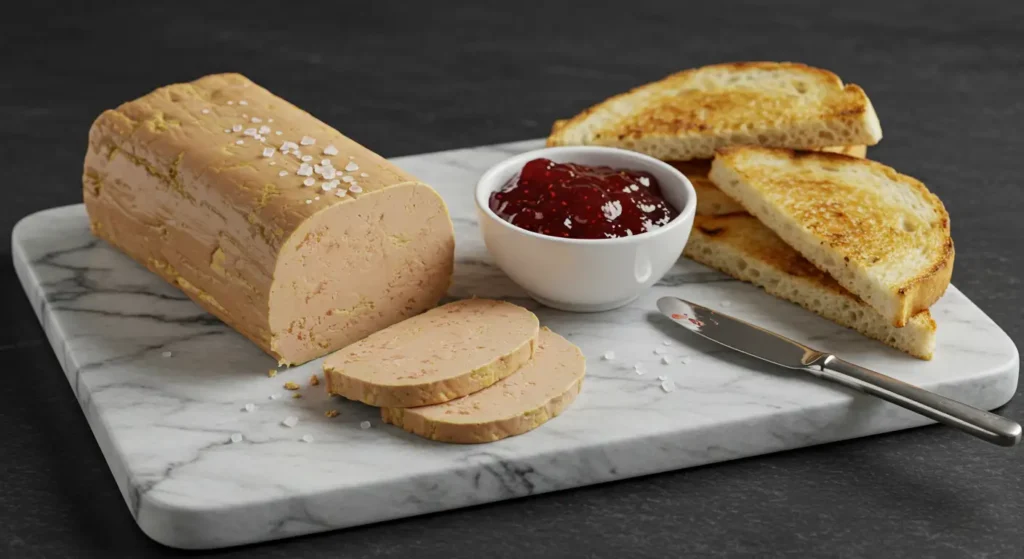
Frequently Asked Questions:
What is foie gras torchon?
Foie gras torchon is a preparation of duck or goose liver, carefully seasoned, wrapped in cloth, and poached to achieve a silky, rich texture. The term “torchon” refers to the cloth used to wrap the liver. This method preserves the delicate nature of the foie gras while allowing its flavors to develop fully.
Which is the best foie gras torchon to buy?
The best foie gras torchon is often sourced from reputable producers like Rougié or Delpeyrat, known for their high-quality, ethically sourced livers. When selecting, look for fresh, artisanal products that emphasize traditional methods. Prioritize products that are free of additives and preservatives for the most authentic experience.
Can you sear foie gras torchon?
While foie gras torchon is typically served without searing, it is possible to lightly sear the outer layer if a crispy texture is desired. However, searing may alter the delicate, buttery texture that defines this preparation. It’s recommended to serve it in its poached form to preserve the smooth, melt-in-your-mouth experience.
How should you serve foie gras torchon?
Foie gras torchon is best served slightly chilled or at room temperature, allowing its rich texture to shine. Pair it with light accompaniments such as toasted brioche, fig jam, or apple compote. For an elegant presentation, garnish with microgreens or edible flowers and a drizzle of balsamic reduction.
What is the perfect jam to pair with foie gras?
Fig jam is a classic pairing with foie gras torchon, offering a sweet yet slightly tangy contrast to the richness of the liver. Apple compote and even onion marmalade can also be great choices for adding balance. The sweetness and acidity from these jams help to cut through the foie gras’ buttery texture.
What does the term ‘torchon’ mean?
“Torchon” is a French term meaning “cloth” or “towel,” which refers to the method of wrapping the foie gras in a kitchen cloth during poaching. This technique allows the foie gras to retain its shape while cooking gently. The cloth also helps in preserving the smooth, creamy texture once chilled.
How long can foie gras be kept in the fridge?
When properly stored, foie gras torchon can be kept in the fridge for up to one week. Ensure it is tightly wrapped in plastic or an airtight container to preserve its freshness. For longer storage, foie gras can also be frozen, though this may affect its texture slightly when thawed.
Conclusion
After experimenting with making foie gras torchon at home and tasting it with some delightful accompaniments, I can honestly say this dish has become one of my favorites. It’s such a treat to share with friends and family, and I love how it always feels like a special occasion. Whether you’re preparing it for the first time or are a seasoned pro, foie gras torchon offers an elegant, luxurious experience that is well worth the effort. So go ahead—get creative, pair it with your favorite jams, toast some brioche, and enjoy every buttery bite! Trust me, it’s a journey worth taking.

